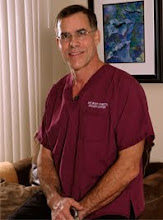Wednesday, August 22, 2012
What it is Like to Have No-Scar Breast Implant Surgery, Part 2
When we left off, you were in the middle of your transumbilical breast augmentation surgery. You had been sedated, had an incision made in your navel, and an instrument had tunneled up to each breast. This allowed for the balloon-expander to create the space for your new implants. When this is removed, the space is then checked for bleeding. Remember that the pressure of the balloon expander has probably stopped any bleeding so far. Then the new pocket is irrigated with a sterile saline solution containing an antibiotic. Antibiotic solution sterilizes the implant pocket to prevent infections. Dr. Yoho is batting 1000 on this record—he can gratefully say that he has not seen a single infection from this procedure. In addition to dangerous infections, minor infections are thought to contribute to the danger of a complication called capsular contracture, or hardening of the breast around the implant. So the antibiotic solution might help to prevent this complication as well.
Next, Dr. Yoho puts a long-acting local anesthetic right inside the implant pocket. Having a local inside the breast has a painkiller effect in the area for up to 8 hours after surgery. This is important so that the patient has plenty of time to take her pain pill after waking up. This keeps the post-op pain to a bare minimum.
Now, it is time to place the actual implants. The tiny incision does not allow for a filled implant to be pushed through the belly button. So the empty implant is placed through the small tunnels under the skin while it is rolled up (like a taquito, as Dr. Yoho describes it). These are threaded up to the breasts using a “no-touch” technique. This technique doesn’t mean that Dr. Yoho operates with a “Look ma, no hands!” kind of recklessness. It means that, although he does use hands, the implant and the patient are both wetted down with the antibiotic saline solution so that all surfaces are sanitized as the surgeon is working. After the implants are in place, they are then filled with sterile saline.
Once the implants are placed and filled, Dr. Yoho sits the patient up. This is to check the evenness of the breasts and the appearance (because we don’t look the same sitting or standing as we do lying down). Although, just like natural breasts, implants are rarely if ever perfectly even, Dr. Yoho checks and adjusts the saline levels to make sure they are as symmetrical as possible. Once the desired levels are reached, Dr. Yoho tugs out the fill tubes. The implants have a valve that self-seals once these tubes come out.
After the tubes come out, your surgery is basically finished. Your breasts will immediately be wrapped with a light elastic bandage to help prevent swelling. A sports bra is placed over this, and an elastic band is placed above the breasts. You will also have a small dressing covering the little belly button incision.
By the time this is completed, you will be awake. Your family or friends can then come in and see you in recovery.
Part 3 will cover the surgical recovery.
Subscribe to:
Post Comments (Atom)


No comments:
Post a Comment